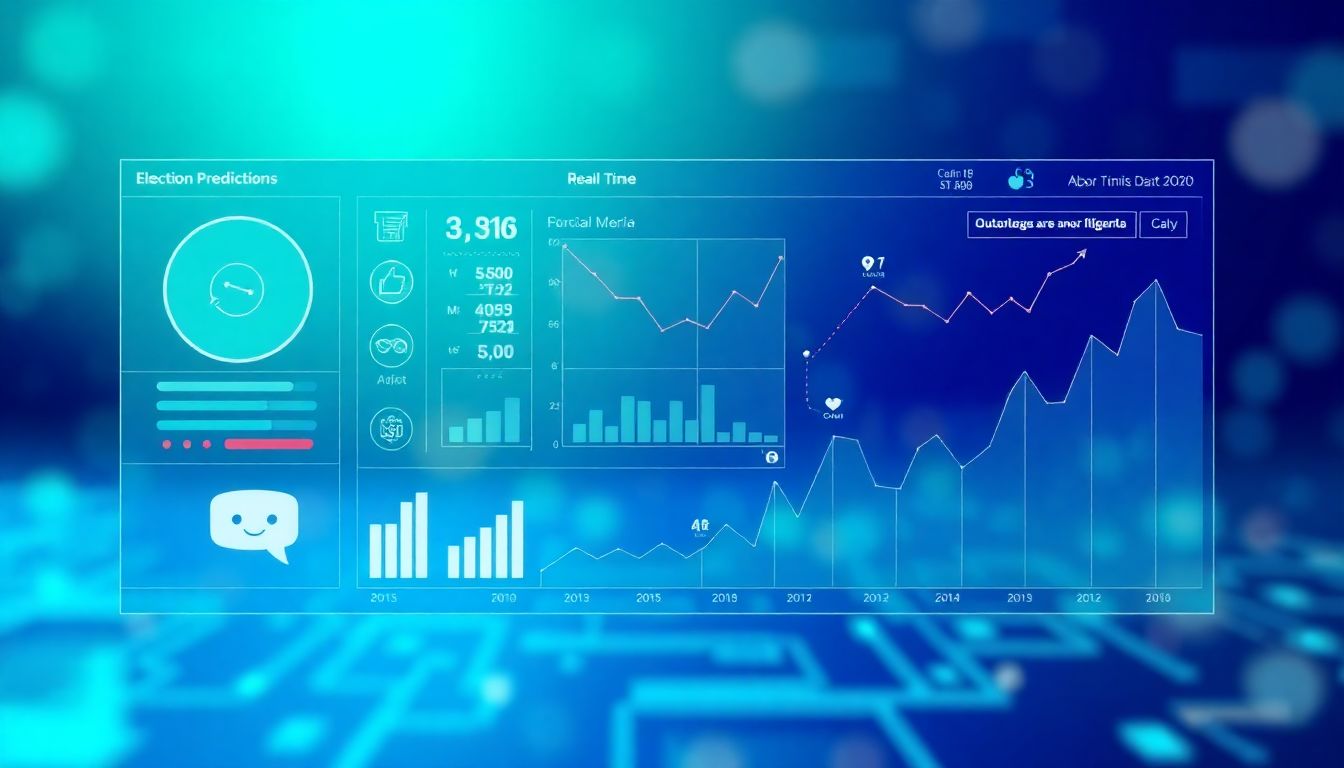Predicting election outcomes can feel like trying to predict the weather—sometimes it’s just plain tricky! With so many factors at play, it’s no wonder people are seeking smarter ways to make sense of it all. If you’ve ever felt overwhelmed by polls and pundits, you’re totally not alone.
But what if I told you there’s a way to simplify this chaos? By using ChatGPT analytics, you can tap into a treasure trove of insights and predictive capabilities. Stick around, and I promise you’ll discover how to harness this powerful tool for more informed predictions.
From understanding key analytics to crafting the perfect prompts, we’re diving into everything you need to know to make predictions that can stand up to the test of traditional methods, and maybe even find a few laughs along the way!
Key Takeaways
- ChatGPT can simplify predicting election outcomes by analyzing data and providing insights.
- Use specific prompts for better accuracy, such as asking about voter trends, polling data, and social media sentiment.
- Inputting multiple data sources enhances the predictions by offering richer context.
- Be aware of limitations; outdated or biased data can skew results.
- Compare ChatGPT predictions with traditional methods to assess effectiveness and accuracy.
- Craft effective prompts by being specific and providing context for clearer insights.

How to Use ChatGPT for Predicting Election Outcomes
Using ChatGPT for predicting election outcomes can streamline the process and enhance your forecasts.
To start, you can input specific data about candidates, demographics, and historical trends for better accuracy.
Simply type prompts such as:
- “Analyze the voter turnout trends for the upcoming election based on historical data.”
- “Provide a forecast for the main candidates based on recent polling data.”
These prompts help you harness ChatGPT’s analytical capabilities to break down complex election data.
Furthermore, you can ask ChatGPT to analyze social media sentiment around candidates, which is crucial for understanding public opinion.
For instance:
- “Summarize the sentiment of social media posts related to Candidate X in the past month.”
- “What issues are resonating most with voters in this election cycle?”
With these insights, you can make informed predictions, backed by AI-generated analysis, that save time and improve understanding.
Understanding Election Analytics with ChatGPT
Election analytics involve examining data to predict outcomes, and ChatGPT can make this analysis accessible and efficient.
Start by gathering available data, including polls, demographic information, and historical election results.
Input your findings into ChatGPT with commands like:
- “Explain the impact of demographic shifts on voter behavior in the last election.”
- “What do the latest polling results indicate about the upcoming election?”
ChatGPT can help interpret this data, providing insights into trends and anomalies that can affect predictions.
Also, try exploring what factors influence voter decisions:
- “Discuss how economic factors played a role in the last presidential election.”
- “Analyze the effect of campaign strategies on voter turnout based on previous elections.”
By leveraging ChatGPT for election analytics, you can gain a clearer picture of the political landscape, leading to more accurate forecasts.
Key Factors ChatGPT Considers in Election Predictions
When predicting elections, ChatGPT considers various factors that impact voter behavior.
First, public sentiment plays a crucial role. You might ask:
- “Analyze recent trends in public opinion polls for the leading candidates.”
- “What factors are influencing voter sentiment about Candidate Y?”
Next, demographics significantly affect election outcomes, so it’s essential to analyze these groups.
Use prompts like:
- “What demographic factors are most likely to influence the election results?”
- “How has the changing demographic landscape affected voting patterns?”
Campaign influence is also essential. In your prompts, include requests such as:
- “Evaluate the impact of Candidate Z’s campaign strategy on their polling numbers.”
- “Discuss how debates have influenced public perception of the candidates.”
By exploring these key factors, you provide ChatGPT the context it needs to assist you in making well-informed predictions.
Examples of Effective ChatGPT Prompts for Elections
Creating relevant prompts is vital for extracting useful insights from ChatGPT when predicting election outcomes.
Here’s a list of effective prompts you can use:
- “What key issues are driving voter interest in the upcoming elections?”
- “Generate a comparison of the top three candidates based on their campaign platforms.”
- “Summarize any recent political scandals and their potential impact on the election.”
- “Predict the election outcome based on the current polling data provided.”
- “Discuss how turnout might differ among various age groups this election.”
Utilizing these prompts not only helps gather insights but also enables you to refine your approach to election forecasting.
For anyone interested in enhancing their writing skills, check out our creative writing prompts for innovative ideas on storytelling and narrative building.
You might also find our journaling prompts insightful, especially for keeping track of political sentiments and election-day experiences.

Limitations of Using ChatGPT for Election Predictions
While ChatGPT is a powerful tool for predicting election outcomes, it’s essential to recognize its limitations.
First, the accuracy of ChatGPT’s predictions depends heavily on the quality and amount of data it processes.
For example, if you input outdated or biased information, the predictions may lead you astray.
You can ask:
- “What are potential biases in this polling data?”
- “Identify any shortcomings in my data sources when predicting election outcomes.”
Additionally, ChatGPT operates on patterns learned from historical data, which means it might struggle to account for sudden changes in public sentiment or unexpected events.
For instance, include prompts like:
- “Analyze the impact of the latest political scandal on voter sentiment.”
- “How might a last-minute debate alter the election dynamics?”
Understanding these limitations helps you approach the predictions with a critical eye, ensuring a balanced view that considers potential inaccuracies.
Improving Your Predictions with Data Enhancement
Enhancing your predictions with diverse data sources can significantly improve the quality of outcomes generated by ChatGPT.
Start by integrating multiple data sources, like polling data, demographic information, and even local news articles.
Consider using commands such as:
- “Combine polling data with demographic insights to predict voter turnout.”
- “Analyze how recent economic changes might affect voting behavior.”
Incorporating historical election data is also vital.
You can ask:
- “Compare historical turnout data from similar demographics to current predictions.”
- “What patterns can be identified from past elections that influence today’s voters?”
By refining your data inputs, you not only provide ChatGPT with richer information but also enhance the reliability of its predictions.
Comparing ChatGPT Predictions with Traditional Methods
Comparing ChatGPT’s predictions with traditional forecasting methods can offer valuable insights into its effectiveness.
For one, traditional methods often rely on expert opinions and historical data, while ChatGPT uses advanced algorithms to analyze data patterns.
You might ask:
- “How do ChatGPT predictions align with expert forecasts for this election?”
- “What are the advantages of using AI predictions over traditional polling?”
Exploring accuracy rates can be enlightening as well.
Consider asking:
- “Compare the accuracy of ChatGPT-generated predictions with recent polling results.”
- “Evaluate the success rate of traditional polling versus AI-assisted forecasts.”
Doing this can highlight the strengths and weaknesses of both approaches, allowing you to make more informed decisions when it comes to election forecasting.
Best Practices for Crafting Prompts for Election Forecasts
To get the most out of ChatGPT for election predictions, crafting effective prompts is crucial.
Start with specificity—being clear about what you want will lead to better responses.
Examples of good prompts include:
- “List five key issues that will likely drive voter turnout in the upcoming election.”
- “Analyze how different demographics might vote in swing states.”
Use context to your advantage; providing background will help ChatGPT deliver more targeted insights.
For instance:
- “Given the latest economic downturn, predict its impact on the presidential candidates’ poll numbers.”
- “Discuss how Candidate A’s recent policy changes have affected their popularity.”
Lastly, keep iterating on your prompts based on the responses you receive—refining the queries can lead to improved predictions.

Future Trends in Election Predictions Using AI
As technology continues to advance, the future of election predictions with AI like ChatGPT looks promising and dynamic.
One trend to watch is the increased use of real-time data analysis.
Imagine being able to analyze voter sentiment as it changes during debates or major news events.
You can utilize prompts such as:
- “Predict how emerging news trends will influence voter sentiment in real-time.”
- “Analyze the immediate impact of the latest debate on candidates’ poll numbers.”
Another trend is the incorporation of machine learning algorithms that adapt and refine predictions over time.
This means the more data you feed into the system, the more accurate its forecasts become.
For example, try asking:
- “How can machine learning improve the accuracy of election predictions?”
- “Discuss the role of evolving algorithms in predicting electoral outcomes.”
Lastly, we can expect to see a surge in the use of predictive analytics tools that merge various data sources, including social media sentiment, economic indicators, and demographic shifts.
A valid prompt might be:
- “Combine analysis of social media trends and economic data to forecast upcoming elections.”
- “Evaluate how merging different data sources enhances predictive accuracy.”
As these innovations develop, they promise to reshape how stakeholders approach election predictions, enabling deeper insights and more informed decision-making.
FAQs
ChatGPT can analyze historical data, interpret trends, and process various inputs, offering predictions on election outcomes based on a range of influencing factors. Its adaptability allows it to refine forecasts as new data emerges.
ChatGPT’s limitations include reliance on historical data, potential biases in training data, and its inability to predict unexpected events accurately. It should be used as a supplementary tool rather than a sole source of prediction.
Improving predictions involves collecting a wider range of high-quality data, integrating real-time analytics, and continually updating the model with new information. This enhances the accuracy and relevance of the predictions made by ChatGPT.
Best practices include being specific in your queries, using clear language, and providing context. This improves the precision of responses and enhances the effectiveness of predictions derived from the prompts.
